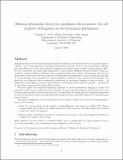Diffusion–deformation theory for amorphous silicon anodes: The role of plastic deformation on electrochemical performance
Author(s)
Anand, Lallit; Di Leo, Claudio V; Rejovitzky, Elisha
DownloadDiLeo_Rejovizky_Anand_IJSS_2015.pdf (1.071Mb)
PUBLISHER_CC
Publisher with Creative Commons License
Creative Commons Attribution
Terms of use
Metadata
Show full item recordAbstract
Amorphous silicon (a-Si) is a promising material for anodes in Li-ion batteries due to its increased capacity relative to the current generation of graphite-based anode materials. However, the intercalation of lithium into a-Si induces very large elastic–plastic deformations, including volume changes of approximately 300%. We have formulated and numerically implemented a fully-coupled diffusion–deformation theory, which accounts for transient diffusion of lithium and accompanying large elastic–plastic deformations. The material parameters in the theory have been calibrated to experiments of galvanostatic cycling of a half-cell composed of an a-Si thin-film anode deposited on a quartz substrate, which have been reported in the literature. We show that our calibrated theory satisfactorily reproduces the mechanical response of such an anode — as measured by the changes in curvature of the substrate, as well as the electrochemical response — as measured by the voltage versus state-of-charge (SOC) response.
We have applied our numerical simulation capability to model galvanostatic charging of hollow a-Si nanotubes whose exterior walls have been oxidized to prevent outward expansion; such anodes have been recently experimentally-realized in the literature. We show that the results from our numerical simulations are in good agreement with the experimentally-measured voltage versus SOC behavior at various charging rates (C-rates).
Through our simulations, we have identified two major effects of plasticity on the electrochemical performance of a-Si anodes:
•
First, for a given voltage cut-off, plasticity enables lithiation of the anode to a higher SOC. This is because plastic flow reduces the stresses generated in the material, and thus reduces the potential required to lithiate the material.
•
Second, plastic deformation accounts for a significant percentage of the energy dissipated during the cycling of the anode at low C-rates.
Hence, plasticity can have either (a) a beneficial effect, that is, a higher SOC for a given voltage cut-off; or (b) a detrimental effect, that is significant energy dissipation at low C-rates.
Date issued
2015-04Department
Massachusetts Institute of Technology. Department of Chemical Engineering; Massachusetts Institute of Technology. Department of Mechanical EngineeringJournal
International Journal of Solids and Structures
Publisher
Elsevier
Citation
Di Leo, Claudio V. et al. “Diffusion–deformation Theory for Amorphous Silicon Anodes: The Role of Plastic Deformation on Electrochemical Performance.” International Journal of Solids and Structures 67–68 (August 2015): 283–296 © 2015 Elsevier Ltd
Version: Author's final manuscript
ISSN
0020-7683